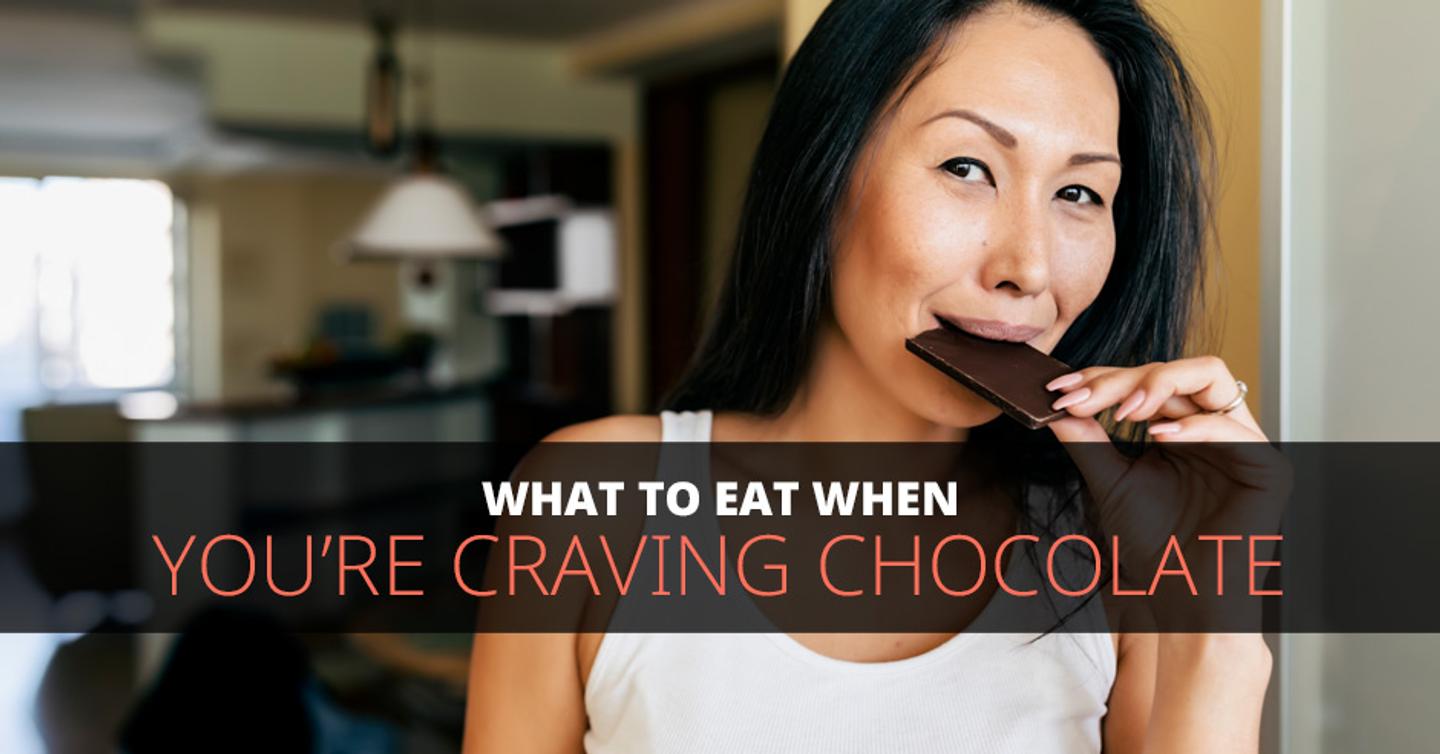
What to Eat When You're Craving Chocolate
Reading Time: 6 minutes 10 seconds
BY: ISSA
DATE: 2023-08-14
Food cravings can be intense. They can also sabotage healthy eating and a successful weight loss journey. A chocolate craving is a big one that many people experience. Give into it and you may find yourself two rows into an Oreos package.
You'll find all kinds of tips and tricks for avoiding what you crave—don't keep it in the house, go for a walk instead—but avoidance isn't always best.
What's better is to understand your chocolate craving, what your body and mind are telling you, and how to substitute something healthier that will satisfy. And sometimes, just eat the chocolate.
ISSA's Nutritionist Specialization is the most comprehensive approach to unlocking the secrets behind why we eat the way we do, and the systematic approach to drive lifestyle change. Sign up today to bridge the gap between what to eat and how to make it a healthy and doable lifestyle.
Why Do We Have Food Cravings?
Specific food cravings may be triggered by nutritional deficiencies. For example, it has been proven that a desire to chew ice chips or cubes can signal an iron deficiency. (1)
In most cases, though, food cravings are more psychological than physiological. Studies using brain scans have shown that thinking about a food you like and crave activates the same parts of the brain as addictive substances. (2)
When you eat a high-sugar or high-fat food, or a food with a satisfactory texture or flavor, you get a release of neurotransmitters with a pleasure sensation. You get a reward every time you eat it, and therefore begin to crave it.
Food cravings can also result from stress and other difficult emotions. Certain foods provide comfort, and so we turn to them at during tough time, even just on a bad day.
Check out this guide for managing and overcoming all types of food cravings so you don't sabotage a healthy diet.
What Does a Chocolate Craving Mean?
Whenever you can make eating more mindful, you'll make healthier choices. Stop to consider why you really want that Hershey bar right now, and you may find that your craving isn't that specific. There's something behind it that can be satisfied another way:
You're Hungry and You Just Want a Snack. If you've ever noticed what a mistake it is to grocery shop when hungry, you understand this aspect of a craving. When hungry you want something delicious and satisfying, and that often means junk food. A
A Chocolate Craving is Often a Sugar Craving. Most chocolate treats are also sugary, so when you want a candy bar it may be the sugar you're really after.
You're Low on Energy. A mid-afternoon slump may have you reaching for chocolate, both for the sugar and the caffeine.
Chocolate is Your Emotional Habit. Habit is a powerful motivator. If you always reach for chocolate as a reward, when you're stressed, or in response to any difficult emotion, you tend to do it without thinking. Before long you've developed a regular craving.
You May Be Deficient in Magnesium. Some researchers have suggested a chocolate craving could indicate a magnesium deficiency. (3) While this is questionable, there may be some validity to it as chocolate does contain significant amounts of magnesium.

6 Healthy Food Choices—What to Eat When You're Craving Chocolate
So what should you eat when the craving for chocolate strikes? Sometimes the simple answer is to eat chocolate. Often it's best to turn to something healthier and that won't lead to a damaging binge. Consider the real source of your craving and make a smart decision, but don't always deny that craving either. If you really want chocolate, eat it in limited amounts.
1. Try Fresh Fruit for Sugar
If what you really want is something sweet, the best choice is a piece of fruit. In addition to getting your sugar fix, naturally, fruits come with fiber to help absorb that sugar slowly and several vitamins and minerals. If the sugar craving is intense, go for the sweetest fruits, like grapes, mangoes, cherries, or pears.
Natural sugars have a place in a healthy diet, but most of us eat far too much added sugar. Learn more about added sugars and how you can keep track to minimize these extra, empty calories.
2. Stay Full with Protein
Hunger masquerading as a chocolate craving means you need a snack that will satisfy and keep you fuller longer. Reach for something high in protein, which takes longer than other nutrients to digest: Greek yogurt, beef jerky, hard-boiled eggs, peanut butter, tuna, cottage cheese, protein bars.
3. Choose Alternative, Healthier Snacks
A protein-filled snack is a great option if you're hungry, but sometimes you just want to indulge in a snack. Deny yourself that craving too often, and you risk binging later. Give into it with something healthier and with fewer calories than many chocolate snacks, and mind your portions:
A handful of nuts or trail mix
Air-popped popcorn with just a little butter and salt
Nut butters with an apple or celery
Veggies and hummus
A handful of olives
Avocado on toast
4. Get out of a Slump with Caffeinated Beverages
A chocolate craving may mean you need a boost of energy. If you're not actually hungry, try a caffeinated drink. Stick with low-calorie drinks, though. A cup of black coffee or a hot, black tea can be satisfying without adding any calories. A little low-fat creamer is fine, though, if you don't like your drinks unadulterated.
5. Choose High-Magnesium Foods
Whether there is any truth to the fact that low magnesium levels can trigger a chocolate craving, the fact is that most Americans do not eat enough of this essential micronutrient. (4) This is a real health problem. Inadequate magnesium may contribute to or cause muscle cramps, fatigue, apathy, high blood pressure, and even osteoporosis because it is needed for effective use of vitamin D.
Almost anyone can benefit from getting more magnesium in their diet, so try these snacks when you crave chocolate (5):
One ounce of almonds - 80 milligrams
One ounce of cashews - 74 milligrams
One-quarter cup of peanuts - 63 milligrams
One-half cup of edamame - 50 milligrams
Two tablespoons of peanut butter - 49 milligrams
6. Craving Chocolate? Eat Chocolate
Chocolate is not inherently bad for you. In fact, the cacao fruit has a lot of nutritional benefits. The problem with eating chocolate is twofold: you are likely to give into a craving by eating too much and most chocolate products are too high in fat, sugar, and other additives.
When you really want chocolate, and no substitute will do, go ahead and eat chocolate, but make a smarter, healthier choice:
Dark chocolate. A dark chocolate bar, with a cocoa content of 60% or higher, leaves little room for fat and sugar. The high level of cacao in it provides healthful antioxidants and flavonoids.
Cocoa powder. Without any added sugar, cocoa powder is pure chocolate and is a healthy ingredient that allows you to control the sugar and fat content. Keep a jar on hand and use it in healthier dessert recipes or in a smoothie sweetened with fruit or another white sugar alternative.
Cacao nibs. These crushed pieces of the cacao bean have a bitter but intensely chocolate flavor. You can find them roasted or raw and are less processed than almost any other chocolate product. Nibble these for a snack to get that chocolate essence along with protein, fiber, magnesium, iron, and manganese.
If you do turn to more processed, higher-sugar content chocolate, just mind your portions and include other foods. Add a few chocolate chips to a mix of nuts, for instance, or use a little chocolate spread on a banana or whole grain toast. If you can control the urge to binge, a little chocolate won't hurt.
Chocolate cravings, or any food craving for that matter, can be detrimental to a diet and good health, but you can control them. The most important thing is to understand your craving. What does your body, and more often your mind and emotions, really want? Is it sugar? Comfort? Energy? Eat more mindfully and enjoy chocolate sparingly for optimal health.
Love Nutrition? Get Certified
Everything you need to be able to advise clients on diet and nutrition is right here: ISSA's Nutritionist Program. Earn your certification online in weeks and expand your services.
Featured Course
ISSA | Nutritionist
By becoming an ISSA Nutritionist, you'll learn the foundations of how food fuels the body, plus step by step methods for implementing a healthy eating plan into clients' lifestyles.
References
Pruthi, R.K. (2018, March 9). Craving and Chewing Ice: A Sign of Anemia? Mayo Clinic. Retrieved from https://www.mayoclinic.org/diseases-conditions/iron-deficiency-anemia/expert-answers/chewing-ice/faq-20057982#:~:text=Craving%20and%20chewing%20ice%20(pagophagia,people%20with%20iron%20deficiency%20anemia.
Fesler, K. (2014, February 11). The Craving Brain. TuftsNow. Retrieved from https://now.tufts.edu/articles/craving-brain
Yanovski, S. (2003, March). Sugar and Fat: Cravings and Aversions. The Journal of Nutrition. 133(3), 835S-837S. Retrieved from https://academic.oup.com/jn/article/133/3/835S/4688015
DiNicolantonio, J.J., O'Keefe, J.H., and Wilson, W. (2018). Subclinical Magnesium Deficiency: A Principal Driver of Cardiovascular Disease and a Public Health Crisis. Open Heart.5(1), e000668. Retrieved from https://www.ncbi.nlm.nih.gov/pmc/articles/PMC5786912/
National Institutes of Health. Office of Dietary Supplements. (2020, March 24). Magnesium. Retrieved from https://ods.od.nih.gov/factsheets/Magnesium-HealthProfessional/